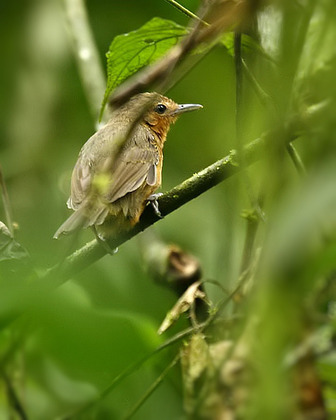Dusky Antbird
This is a common bird in the understory thickets of wet forest, especially at edges and clearings, and in adjacent tall second growth. The female lays two reddish-brown-spotted white eggs, which are incubated by both sexes, in a small, deep, plant fibre and dead leaf cup nest, which is suspended from the fork of a thin branch or vine low in a tree. The male and female parents both feed the chicks.

Original source: Michael WoodruffPermission(Reusing this file)This image, which was originally posted to Flickr.com, was uploaded to Commons using Flickr upload bot on 00:27, 13 November 2008 (UTC) by Snowmanradio (talk). On that date it was licensed under the license below. This file is licensed under the Creative Commons Attribution-Share Alike 2.0 Generic license.You are free:to share – to copy, distribute and transmit the work
Author: Michael WoodruffPermission(Reusing this file)This image, which was originally posted to Flickr.com, was uploaded to Commons using Flickr upload bot on 00:27, 13 November 2008 (UTC) by Snowmanradio (talk). On that date it was licensed under the license below. This file is licensed under the Creative Commons Attribution-Share Alike 2.0 Generic license.You are free:to share – to copy, distribute and transmit the work
The Dusky Antbird is classified as Least Concern. Does not qualify for a more at risk category. Widespread and abundant taxa are included in this category.
Dusky antbirds are members of the suboscine passerine family Thamnophilidae, a species-rich neotropical group (Sibley and Monroe, 1990Go). Pairs defend territories year-round in brushy forest edge habitat where they forage 0.5-10 m up in vines, and vine-covered tree branches, shrubs, and grass. Nests are small (ca 23 cm long) bags made of black rhizomorphs (fungal "horsehair"), suspended 1-4 m above the ground from the end of vertical vines or bamboo shoots (Chusquea spp. More
Dusky Antbird in Gamboa, Panama Province, Republic of Panama. This is the first report of egg destruction by a tropical wren species. = National Zoological Park Smithsonian Institution Washington, DC 20008 USA DESTRUCCION DE UN HUEVO DE CERCOMACRA TYRANNINA POR THR YOTHORUS MODESTUS Sinopsis.-Un individuo de Thryothorus modestus fue observado perforando uno de dos hue- vos de un nido de Cercomacra tyrannina en Gamboa, Provincia Panama, Repfiblica de Pan- ama. More
some, such as the Dusky Antbird, can take as long as 20 days. The altricial chicks are born naked and blind. Both parents brood the young until they are able to thermoregulate, although, as with incubation, only the female broods at night. In common with many songbirds, the parents take faecal sacs for disposal away from the nest. Both parents feed the chicks, often bringing large prey items. When the chicks reach fledging age, after 8–15 days, attending parents call their chicks. More
The Dusky Antbird or Tyrannine Antbird, Cercomacra tyrannina, is a passerine bird in the antbird family. It is a resident breeder in tropical Central and South America from southeastern Mexico southwards to western Ecuador, and Amazonian Brazil. This is a common bird in the understory thickets of wet forest, especially at edges and clearings, and in adjacent tall second growth. More
The Dusky Antbird is typically 14.5 cm long, and weighs 18 g. The adult male is mainly blackish-grey above and paler grey below, with two white wing bars. The female has brown upperparts and rufous-cinnamon underparts. Young birds, especially males, are darker than the adults. Exact plumage shades vary geographically, since there are a number of subspecies of this antbird. More
Family : Thamnophilidae
Genus : Cercomacra
Species : tyrannina
Authority : (Sclater, 1855)
